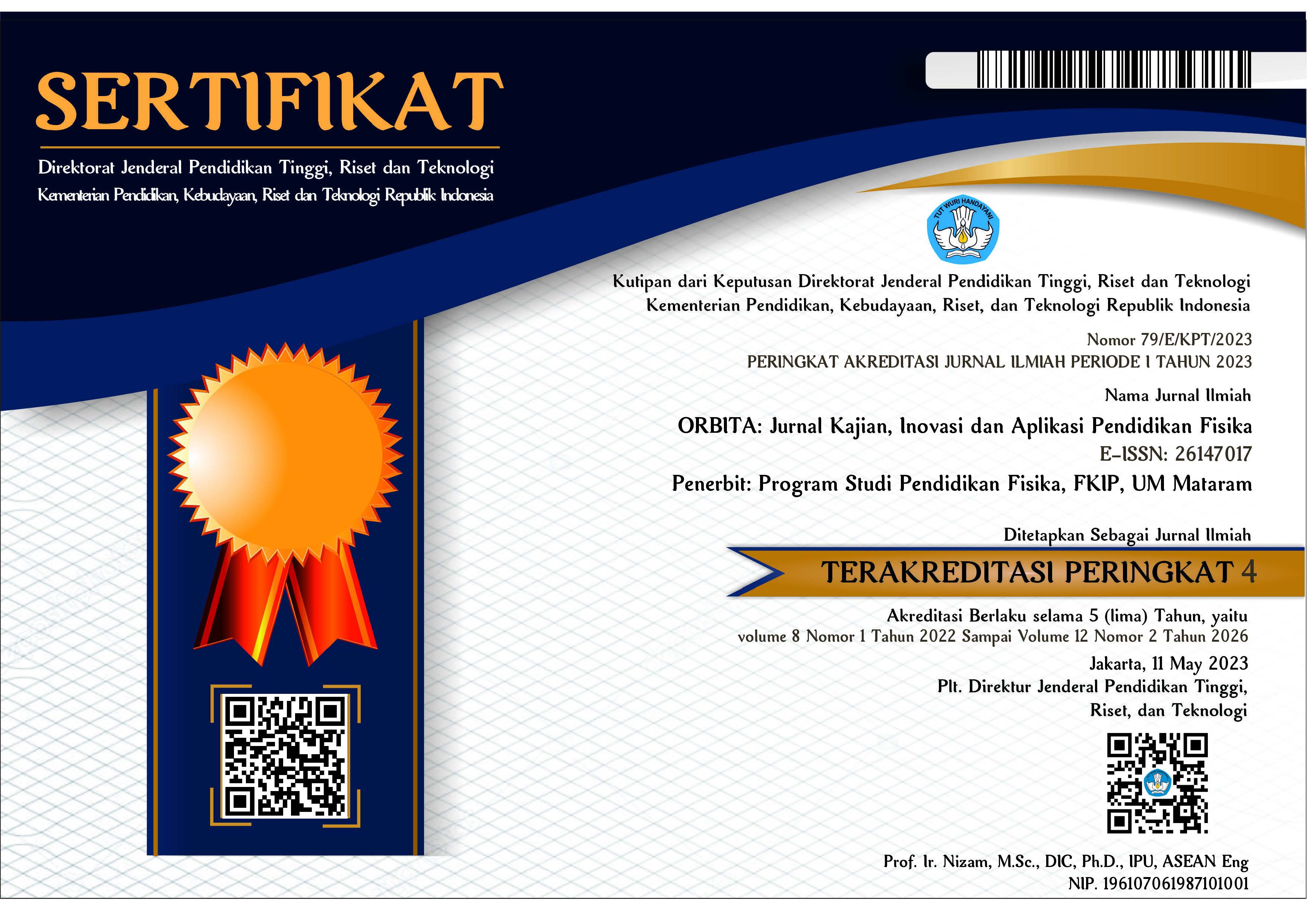PENGARUH PAPARAN MEDAN MAGNET EXTREMELY LOW FREQUENCY (ELF) TERHADAP DERAJAT KEASAMAN (pH) BUAH TOMAT
Abstract
ABSTRAK
Extremely Low Frequency (ELF) adalah spektrum gelombang elektromagnetik frekuensi 0-300Hz . Penelitian radiasi dari medan magnet ELF berdampak positif bagi bahan pangan karena bersifat non-ionizing. Tomat merupakan buah dengan kandungan gizi yang tinggi, namun memiliki masa simpan yang pendek yaitu ± 7-8 hari pada suhu diatas C. Alternatif cara memperpanjang umur simpan tomat adalah dengan paparan radiasi medan maget ELF. Tujuan penelitian ini adalah untuk menganailis ada atau tidaknya pengaruh ELF pada pH tomat. Sampel yang digunakan adalah tomat berjenis Apel (Lycopersicum Pyriporme). Jenis penelitian yang digunakan adalah penelitian eksperimen laboratorium dan desain penelitian Rancang Acak Lengkap. Sampel berjumlah 180 buah terbagi atas kelompok kontrol (30 sampel) dan kelompok eksperiman (150 sampel) dengan perlakuan medan magnet ELF intensitas 600 µT dan 1000 µT selama 30, 60 dan 90 menit. Penelitian dikerjakan selama 20 hari. Pengolahan data dan analisis data dilakukan dengan uji kruskal wallis melalui software IBM Statistic SPSS 23. Kesimpulan hasil yang didapatkan bahwa adanya pengaruh paparan medan magnet ELF terhadap sampel ditandai dengan perubahan nilai pH akibat aktivitas mikroorganisme patogen dalam tomat yang terganggu. Hal tersebut dibuktikan dengan grafik hasil perubahan pH setiap pengukuran kelompok kontrol sangat tajam perubahannya dibandingkan kelompok eksperimen yang cenderung berubah dengan selisih sedikit.
Kata kunci: radiasi; extremely low frequency; tomat apel (lycopersicum pyriporme)
ABSTRACT
Extremely Low Frequency (ELF) is a spectrum of electromagnetic waves with a frequency of 0-300Hz. Research Radiation from the ELF magnetic field has a positive impact on foodstuffs because it is non-ionizing. Tomato is a fruit with high nutritional content, but has a short shelf life of ± 7-8 days at temperatures above C. An alternative way to extend the shelf life of tomatoes is by exposure to ELF magnetic field radiation. The purpose of this study was to analyze the presence or absence of the effect of ELF on tomatoes. The sample used was apple tomato (Lycopersicum Pyriporme). The type of research used is a laboratory experiment research and a completely randomized design research. A total of 180 samples were divided into a control group (30 samples) and an experimental group (150 samples) with the ELF magnetic field treatment with an intensity of 600 T and 1000 T for 30, 60 and 90 minutes. The research was carried out for 20 days. Data processing and data analysis was carried out by using the Kruskal Wallis test using the IBM Statistical SPSS 23 software. The conclusion of the results obtained was that the effect of exposure to the ELF magnetic field on the sample was marked by changes in pH values due to disturbed activity of pathogenic microorganisms in tomatoes. This is evidenced by the graph of the results of changes in pH for each measurement of the control group, the changes are very sharp compared to the experimental group which tends to change with a slight difference.
Keywords: radiation; extremely low frequency; apple tomato (lycopersicum pyriporme)
Keywords
Full Text:
PDFReferences
Guo, L., Azam, S. M. R., Guo, Y., Liu, D., & Ma, H. (2021). Germicidal efficacy of the pulsed magnetic field against pathogens and spoilage microorganisms in food processing: An overview. Food Control, 108496. https://doi.org/10.1016/j.foodcont.2021.108496
Impe, J. V., Smet, C., Tiwari, B., Greiner, R., Ojha, S., Stulić, V., Vukušić, T., & Režek Jambrak, A. (2018). State of the art of nonthermal and thermal processing for inactivation of micro-organisms. Journal of Applied Microbiology, 125(1), 16–35. https://doi.org/10.1111/jam.13751
Kthiri, A., Hidouri, S., Wiem, T., Jeridi, R., Sheehan, D., & Landouls, A. (2019). Biochemical and biomolecular effects induced by a static magnetic field in Saccharomyces cerevisiae: Evidence for oxidative stress. PLoS ONE, 14(1). https://doi.org/10.1371/journal.pone.0209843
Lubis, E. R. (2020). Bercocok tanam tomat untung melimpah. In Bercocok tanam tomat untung melimpah. Bhuana Ilmu Populer.
Ma, M., de Silva, D. D., & Taylor, P. W. J. (2020). Black mould of post-harvest tomato (Solanum lycopersicum) caused by Cladosporium cladosporioides in Australia. Australasian Plant Disease Notes, 15(1). https://doi.org/10.1007/s13314-020-00395-8
Niati, E. W. (2021). Pengaruh Medan Magnet Extremely low Frequency (ELF) terhadap Massa jenis, PH dan ketahanan fisik buah anggur hitam (Vitis Vnivera). In Skripsi. Pendidikan Fisika Universitas Jember.
Rosyidah, A., Sudarti, & Harijanto, A. (2017). Pengaruh Paparan Medan Magnet Elf (Extremely Low Frequency) Pada Proses Pertumbuhan Jamur Tiram. Journal Pendidikan Fisika, 2(September), ISSN : 2527-5917.
Siahaan, J. M., Aviantara, I. gusti ngurah, & Tika, I. wayan. (2020). Strategi Pengendalian Pascapanen Mutu Tomat (Solanum lycopersicum) di Desa Angseri Kabupaten Tabanan Bali. Jurnal BETA (Biosistem Dan Teknik Pertanian ), 8(2), 380–388. https://doi.org/https://doi.org/10.24843/JBETA.2020.v08.i02.p24
Sudarti, Bektiarso, S., Prastowo, S. H. B., Fuad, F., & Trisnawati, I. J. (2018). Radiation Potential of Extremely Low Frequency (ELF) Magnetic Field to Increase Tobacco Production. International Journal of Engineering and Technology, 10(6), 1633–1640. https://doi.org/10.21817/ijet/2018/v10i6/181006009
Sudarti, S., Rosyidah, A., Ridlo, Z. R., Bektiarso, S., Ardiani, T., & Astutik, S. (2017). Analysis of Extremely Low Frequency (ELF) Magnetic Field Effect to Oyster Mushroom Productivity. International Journal of Advanced Engineering Research and Science, 4(10), 1–8. https://doi.org/10.22161/ijaers.4.10.1
Sukestiyarno. (2014). Statistika Dasar. Andi.
Yaouba, A., Nnomo, E. K., Ze Medjap, A. S., & Essola Etoa, L. C. (2017). Antibacterial effect of Chromolaena odorata extracts on some Erwinia isolates, causal agents of tomato fruit rot in Dschang, Cameroon. Agriculture and Food Security, 6(1), 4–9. https://doi.org/10.1186/s40066-017-0132-6
DOI: https://doi.org/10.31764/orbita.v8i1.8395
Refbacks
- There are currently no refbacks.

This work is licensed under a Creative Commons Attribution-ShareAlike 4.0 International License.
______________________________________________________
ORBITA: Jurnal Pendidikan dan Ilmu Fisika
p-ISSN 2460-9587 || e-ISSN 2614-7017
This work is licensed under a Creative Commons Attribution-ShareAlike 4.0 International License.
EDITORIAL OFFICE:


























